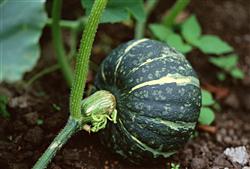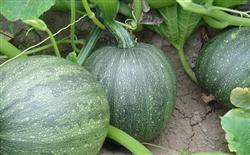How do powdery pumpkins grow in the mountains in summer?

How do powdery pumpkins grow in the mountains in summer? Please introduce in detail that powdered pumpkin has the advantages of strong adaptability, short growth period, good melon type, waxy taste, sweet palatability, rich nutrition, excellent quality, high yield and so on. Powdered pumpkin varieties are golden chestnut pumpkin, Dongsheng pumpkin, tangerine pumpkin and so on. The trial planting of powdered pumpkin was successful. The powdered pumpkin cultivated in high mountains was put on the market from August to September, which played an important role in alleviating the off-season supply of summer and autumn vegetables, increasing varieties of flowers and colors, and enriching market supply, and its economic and social benefits were good. 1. Variety selection: disease resistance, high temperature tolerance, strong fruiting power, good drought tolerance, suitable for alpine cultivation of powdery pumpkin varieties. The trial planting of chestnut pumpkin, golden chestnut pumpkin, Dongsheng pumpkin and tangerine pumpkin are more suitable for alpine cultivation. 2. Plot selection 1. The suitable altitude and topography of powdery pumpkin seed germination temperature is 2528 ℃, the most suitable temperature for plant growth is 18,32 ℃, the temperature for flowering and fruiting is more than 15 ℃, the optimum temperature for fruit development is 25 ℃, and the flower organ can not develop normally when it is above 35 ℃. The flowering and fruiting period of powdery pumpkin cultivated in high mountains is mainly from July to September. In order to meet the requirements of the environmental conditions for the growth and development of powdery pumpkins, we can generally grow powdery pumpkins at an altitude of 550m to 1300m above sea level, and the best elevation is 700m to 1100m above sea level. and south slope, east slope, southeast slope facing the land is better. 2. Soil selection and rotation of powdered pumpkin have wide adaptability to soil. Generally, it is better to choose sandy loam or loam with deeper soil layer, more organic matter, loose and fertile soil and good drainage and irrigation. Third, the selection of sowing time for silty pumpkin cultivation in high mountains should be from early May to early July. The period from sowing to the beginning of harvest of powdery pumpkin is 50-60 days, and the harvest time is 1-1.5 months. Vegetable farmers with large area of alpine powdery pumpkin can sow in stages and go on the market in a balanced manner. In order to prevent flowers and fruits from falling caused by high temperature, the sowing time of low-altitude plots should be postponed, and the sowing time of high-altitude plots can be slightly earlier. Fourth, cultivating strong seedlings is the key to the high yield of alpine powdery pumpkin. In order to make the seeds emerge quickly, completely and neatly, it is necessary to select seeds, disinfect and soak seeds to accelerate germination before sowing. In order to cultivate the nutritive soil for strong seedlings, it is best to choose the vegetable garden soil that has not planted melon crops in 2-3 years, and the nutrient soil should be treated with mature organic fertilizer, calcium superphosphate and plant ash. There are two basic methods of seed disinfection: soaking seeds in ① warm soup. The water temperature is 55 ℃ and the water consumption is 5-6 times of the seed volume. Keep stirring when soaking the seeds and keep the water warm for 15 minutes. ② medicament treatment. The chemical treatment can be divided into two methods: soaking seeds with solution and seed dressing with powder. Soaking the seeds in medicine solution is to soak the seeds in water for about 2 hours, drain and then soak the seeds into a certain concentration of medicine solution, wash and dry after 10 minutes, commonly used agents are 1% potassium permanganate, 40% formalin and so on. Seed mixing with medicinal powder is to mix the medicament and the seed evenly to make the medicament adhere to the surface of the seed. The dosage of medicine is generally 0.1%-0.5% of the seed weight, and the commonly used agents are dimethazone, carbendazim and so on. The seeds that have been sprouted or soaked are sowed in a nutrition bowl, or evenly sowed on the bed soil, covered with 1 cm thick soil, covered with sparse straw, protected from shade and rain. When the seedlings were unearthed for 4 days, the straw was removed, and the temperature was controlled at 26: 30 ℃ during the day and 15 ℃ at night. When the seedling has 4 true leaves, it can be refined and planted. Fifth, the main and lateral roots of powdery pumpkin are well developed in soil preparation, which requires deep ploughing. Deep ditches and high beds are conducive to drainage and irrigation. In the application of fertilizer, attention should be paid to the combined application of nitrogen, phosphorus and potassium, and emphasis should be placed on the application of nitrogen and potassium. Base fertilizer is generally applied in ditches, ditched in the middle of the border, and applied one week before planting, 1500 kg of rotten organic fertilizer, 15 kg of ternary compound fertilizer and 40 kg of superphosphate per mu. Before planting, the seedling bed was sprayed once and fertilizer was applied once, so that it could be planted with fertilizer and medicine. Powdery pumpkin is trailing, with sturdy stems, few branches and low fruiting parts. 6-7 nodes begin to produce melons, which is suitable for close planting. It can be cultivated on the ground or on a shelf. Climbing cultivation, planting about 350 plants per mu; frame cultivation, planting 600 plants per mu. Click to get more pumpkin planting techniques click to get more vegetable planting techniques
- Prev

What are the characteristics of pumpkin fertilizer?
What are the characteristics of pumpkin fertilizer? Please introduce in detail the characteristics of fertilizer requirement of pumpkin: (1) Fertilizer absorption characteristics of root system: pumpkin root is well developed, the main root is about 2 meters deep, the first lateral root has more than 20, about 50 cm long, the longest can reach 140 cm, and can be divided into three or four lateral roots, forming a strong root group.
- Next

How to cultivate Edible Pumpkin seedlings
How to cultivate edible pumpkin seedlings? Please guide one or two pumpkins in the cultivation process generally do not use pesticides, its tender melons, old melons, melon flowers, petioles, shoots and other vegetables can be eaten, especially the tender shoots stir-fried, taste light and crisp, delicious and delicious, it is a good product of vegetables, favored by consumers. Yuanan, Hubei Province.
Related
- Where is it suitable to grow horseradish in China? it is expected to see the middle altitude horseradish in Alishan.
- How to prevent tomato virus disease reasonably? (Control methods included)
- Many people like to plant towel gourd on the balcony. What are the main points of this method and management?
- What crops can chili peppers be mixed with?
- Fertilization techniques and matters needing attention in Tomato
- What are the grafting techniques for peach seedlings in spring?
- Harm and control methods of root swelling disease of Chinese cabbage
- What are the pests of sweet potatoes? How to prevent and cure it?
- Symptoms, causes and Control methods of navel Rot in Tomato
- The cause of "Cucumber rotten bibcock" in Farmers' planting Cucumber and its Control Plan

